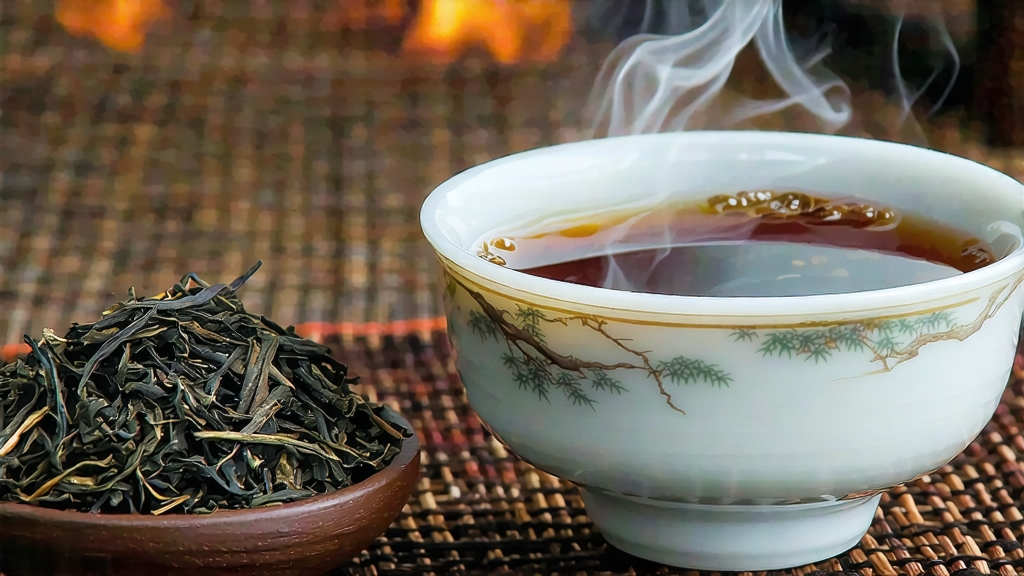
Long before Assam, Ceylon, or Earl Grey entered the global lexicon, the first fully oxidized leaf ever to be called “black tea” was born in the rugged Wuyi Mountains of northern Fujian. Locals still speak its name with reverence—zhengshan xiaozhong—yet outside China most drinkers know it only by its Cantonese trading label: Lapsang Souchong. Few realize that every keg of brisk breakfast tea now poured from Dublin to Delhi descends, genetically and conceptually, from this small, smoke-kissed leaf dried over pinewood in a granite canyon 800 metres above sea level. To understand Lapsang Souchong is to hold the origin story of black tea itself.
History: From Ming Outlaws to London Coffeehouses
Legend dates the birth to 1646, when Qing troops pressed into the Wuyi. Villagers of Tongmu, alarmed that fresh leaf would wither before it could be processed, hastily dried it over open pine fires to halt oxidation. The improbable result—leathery strips exuding resinous fragrance—reached the port of Xiamen, where Dutch traders christened it “bohea” (Fujianese “Wu-i”) and shipped it around the Cape of Good Hope. By 1669 the British East India Company listed “Lapsang Souchong” (literally “small sort from Lapu Mountain”) at 28 shillings a pound, ten times the price of green tea. Samuel Pepys drank it; Catherine of Braganza served it at court; and in 1840 it became the base for the very first Earl Grey blend. Thus a Qing war fugitive’s accident turned into the taste that launched a thousand clippers.
Micro-Terroir: Why Only Tongmu Can Be “Zhengshan”
Chinese law draws a tight protective circle: only leaf picked within the 565 km² core of the Wuyi National Nature Reserve may bear the name zhengshan xiaozhong. Here a subtropical monsoon collides with mineral-rich granite soils, morning fog refracts ultraviolet light, and the average annual humidity hovers at 78 %. Indigenous Cai Cha and Xiao Ye Zhong bushes, often seeded by birds among ferns and orchids, yield leaves unusually high in geraniol and linalool—aromatic compounds that marry with pine smoke to create the tea’s signature “longan and pipe-tobacco” note. Outside the gorge, even identical cultivars and firing techniques produce a flatter cup; connoisseurs can blind-taste the difference.
Grades: Smoky, Unsmoked, and the Rare “Junyee”
- Traditional Song Zhong (pine-smoked): Harvested in late April, withered over local Masson pine and Chinese red pine fires, then pan-fired and rolled before a final 6–8 hour smoke-drying. The best lots, called “Junyee,” use resin-rich heartwood and are rested six months to mellow.
- Wuyi Unsmoked (xiaozhong): Same leaf, but dried with hot air alone, yielding a malty, honeyed liquor reminiscent of dried apricot; preferred in modern China and increasingly in Europe.
- Organic “Wild Bush” micro-lots: Picked from 100-year-old trees on cliffs reachable only by rope; lightly smoked with cypress and cedar for a cooler, resin-sweet finish. Annual yield: under 60 kg.
Craft: The Eight Stages of Pine-Fire Alchemy
- Pluck: one bud, two leaves, 5–9 a.m. when dew still shields polyphenols.
- Solar withering: 20 minutes on bamboo screens to reduce 15 % moisture.
- Indoor withering: 4–6 hours in a second-floor loft above the smoking room; ambient heat and pine volatiles begin enzymatic oxidation.
- Rolling: 40 minutes on cast-iron trays to rupture cells; leaves exude a sticky fruit scent.
- Oxidation: 3–5 hours in cedar-lined boxes at 24 °C, 85 % humidity; leaf turns chestnut.
- Pan-kill: 220 °C for 3 minutes to arrest oxidation at 90 %, locking in maltol.
- Rolling & strip-shaping: repeated twisting forms the tight,